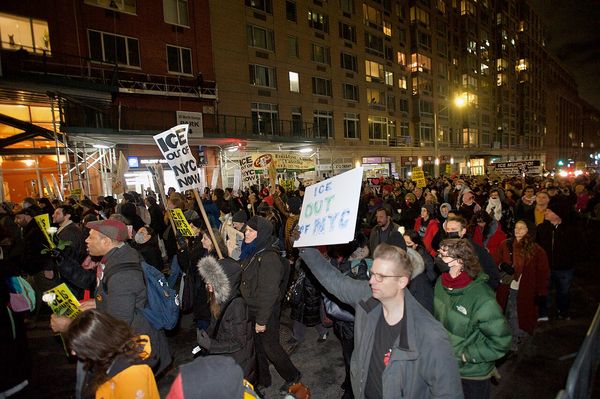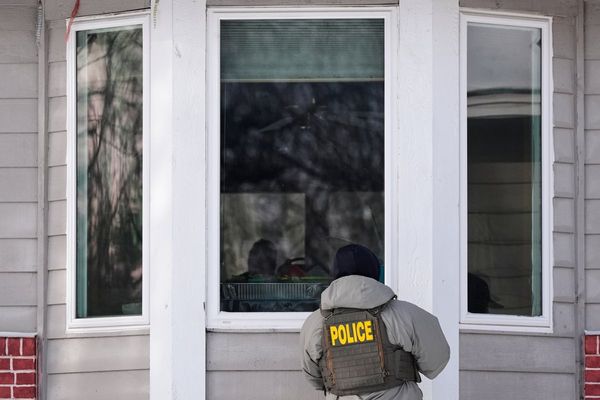
There is no light at night in the Nur Shams refugee camp other than that of a bright moon, although even that doesn’t fully penetrate the maze of narrow alleyways; since 7 October, residents here have stretched sheets of black tarpaulin across the camp’s streets to block the view of Israeli attack drones.
In an uncovered passageway no more than a metre wide between the camp’s shoddily constructed homes, Mohammed al-Jaber, known as Abu Shuja’a, the 25-year-old leader of the local Palestinian Islamic Jihad (PIJ) cell, greeted a dozen young men who emerged from the darkness.
Like him, they were dressed in black and carrying pistols and rifles. The militants had dodged Israeli checkpoints, drones and location tracking technology on their 60km journey from Jenin because there was work to discuss, Abu Shuja’a said.
This is the new reality in Nur Shams, just four kilometres away from the green line and separation wall that divides the occupied West Bank from Israel. Months of airstrikes and fierce street battles with Israeli forces have devastated the camp, earning it the nickname “Little Gaza.”
There are destroyed buildings everywhere, including the youth centre, while roads have been churned up by tanks. Water and electricity are often out; piles of tyres lie in the central square, ready to be set alight to impede the next Israeli raid. At every entrance, men with walkie-talkies signal the camp’s comings and goings, on alert for undercover Israeli operatives or anything unusual. Gas canisters to be used for making improvised explosive devices (IEDs) are not hidden away.
“Look at our lives here,” a commander, Saeed al-Jaber, said during a recent visit by the Guardian last month. “The Mediterranean sea is 10km away, you can see it from the hill, but I have never been there. The Israelis call us terrorists because we don’t want to live in a prison.” A few weeks later, he was killed in a drone attack.
For the past nine months, the death and destruction caused by Israel’s campaign in Gaza, in response to Hamas’s 7 October attack, has dominated the world’s attention. But the other Palestinian territory – the West Bank, including East Jerusalem – is also facing spiralling bloodshed.
The Israel Defense Forces (IDF) raids on militants in refugee camps such as Nur Shams are not new. There are 19 camps across the West Bank, set up for Palestinians expelled from their homes after the creation of Israel, and many have long functioned as centres of resistance against the 57-year-old occupation. Today, they resemble slums, and still suffer from high rates of poverty, crime and unemployment.
In March 2022, the IDF launched Operation Breakwater, near-nightly raids focusing mostly on the West Bank’s camps, in response to the deadliest spate of Palestinian terrorist attacks on Israelis in 20 years.
Since then, the situation in the West Bank has rapidly deteriorated; young men in the camps say they have no choice except to pick up weapons in order to defend their communities against the Israeli incursions. The Palestinian Authority, which is nominally in control of towns and cities in the West Bank and coordinates on security matters with Israel, hold no sway in the camps.
Even before the 7 October attack, 2022 and 2023 were the most violent years on record since the second intifada, or Palestinian uprising, of the 2000s. Israel resumed using helicopter gunships and targeted drone attacks in the territory last summer, and since the war in Gaza broke out has begun using extensive air power.
The death toll is steadily rising. According to Ocha, the UN’s humanitarian agency, between 7 October 2023 and 24 June 2024, 536 Palestinians, including 130 children, have been killed in the West Bank, mostly in clashes with Israeli forces and settlers.
Several incidents for which video evidence exists suggest that Israeli soldiers shot unarmed men and boys; other civilians have been caught up in raids and targeted attacks on militants. In Nur Shams this week, an armoured IDF vehicle ran over an IED and exploded, killing a soldier; an Israeli drone strike on the camp a night later killed at least four people whom the IDF identified as members of PIJ; local media reports said one of the dead was a woman.
Sarah Mahameed, 20, was traumatised by watching her 15-year-old brother Taha die after he was shot by an Israeli sniper in front of their home in November. Anyone that tried to help him was also shot; her father, Ibrahim, died of his wounds in hospital three months later.
“There are no rules any more. They just want revenge,” she said.
The IDF says it operates in the camps and elsewhere in the West Bank to combat terrorism. Since 7 October, there has been a significant increase in attempted attacks; the army puts the number at more than 2,000.
“The mission of the IDF is to maintain the security of all residents of the area, and to act to prevent terrorism and activities that endanger the citizens of the state of Israel,” a spokesperson said.
The escalating violence is fuelling both armed Palestinian resistance and popular support for groups such as Hamas and PIJ, several Nur Shams residents said.
The new generation of fighters in the West Bank are for the most part only loosely affiliated with the traditional Palestinian factions such as Hamas, Islamic Jihad and the secular Fatah. Abu Shuja’a, the PIJ commander, said he used to be a member of Fatah, but switched allegiance to PIJ after raids on the camp intensified in the wake of 7 October.
Many Palestinians have suggested that the Iran-backed group is better supplied with weapons and money in the West Bank than other factions. Anecdotally, it appears that support for PIJ, rather than Hamas, is stronger in several camps than it was before the conflict began.
“We fight for Palestine against the occupation, We would fight under the banner of anyone who helps us defend ourselves,” Abu Shuja’a said.
Similar situations are playing out all over the West Bank: along with Nur Shams, nearby Tulkarm, Jenin, Nablus and Qalqilya also bear many new scars that will take a generation to heal. The children of Nur Shams idolise Abu Shuja’a and his men, asking to hold their guns and posing for photos. There are only about 7,000 people living here: many of the killed fighters, now immortalised in martyr posters, are their brothers, fathers and cousins.
At the Nur Shams graveyard, the caretaker had to begin preparing a new plot in October; about 70 people have been killed and buried here since. Umm Sulieman, 67, cried over her son’s grave and showed the Guardian pictures and video of him: the 30-year-old father of two had had nothing to do with the fighting, she said, and was killed in a drone attack that was targeting someone else. She is deathly afraid for her family’s future.
“What are we supposed to do? I want my children and grandchildren to have hope and a better life. Instead, I am burying them,” she said.







